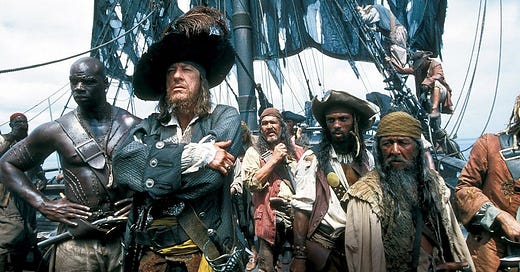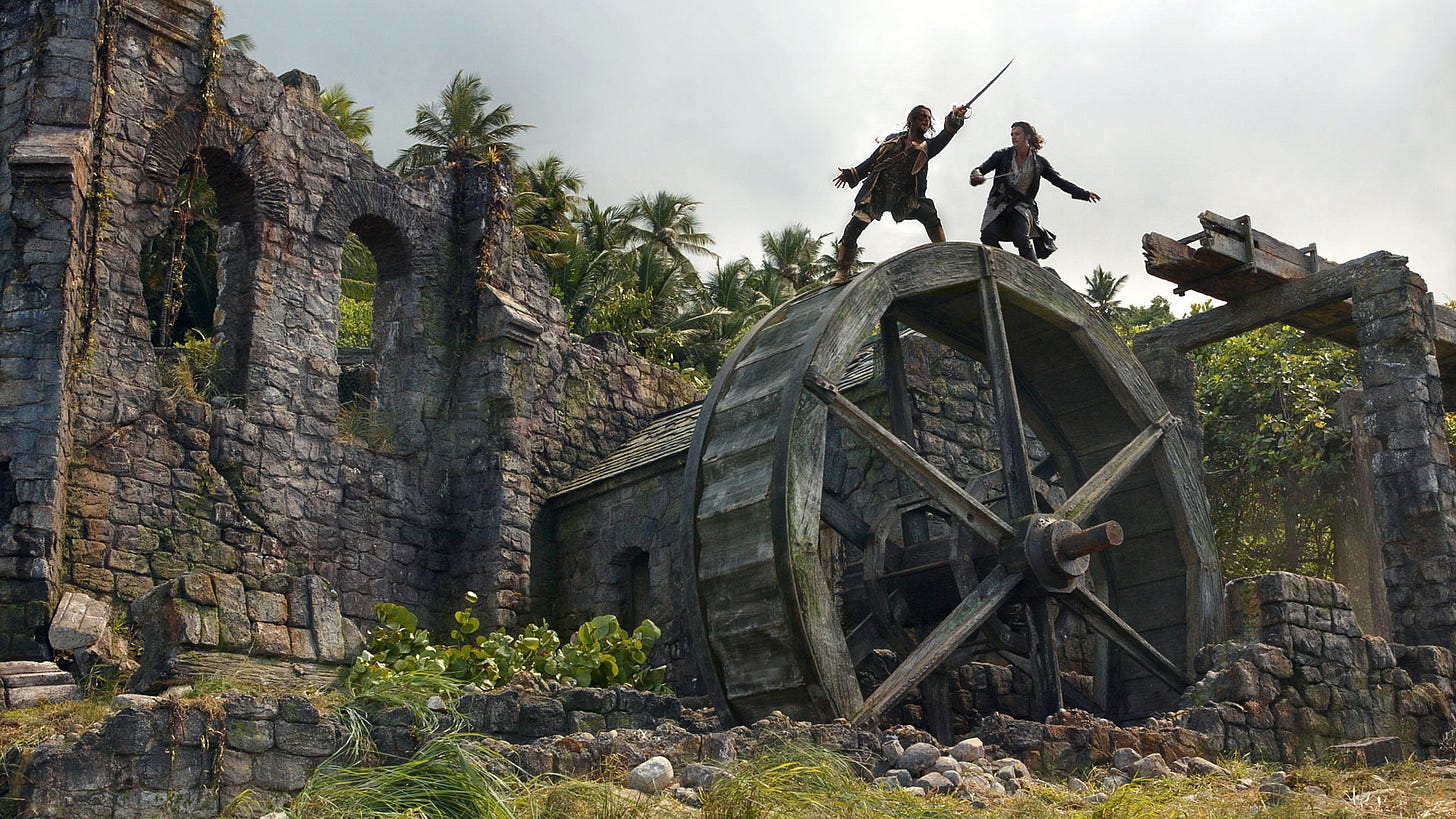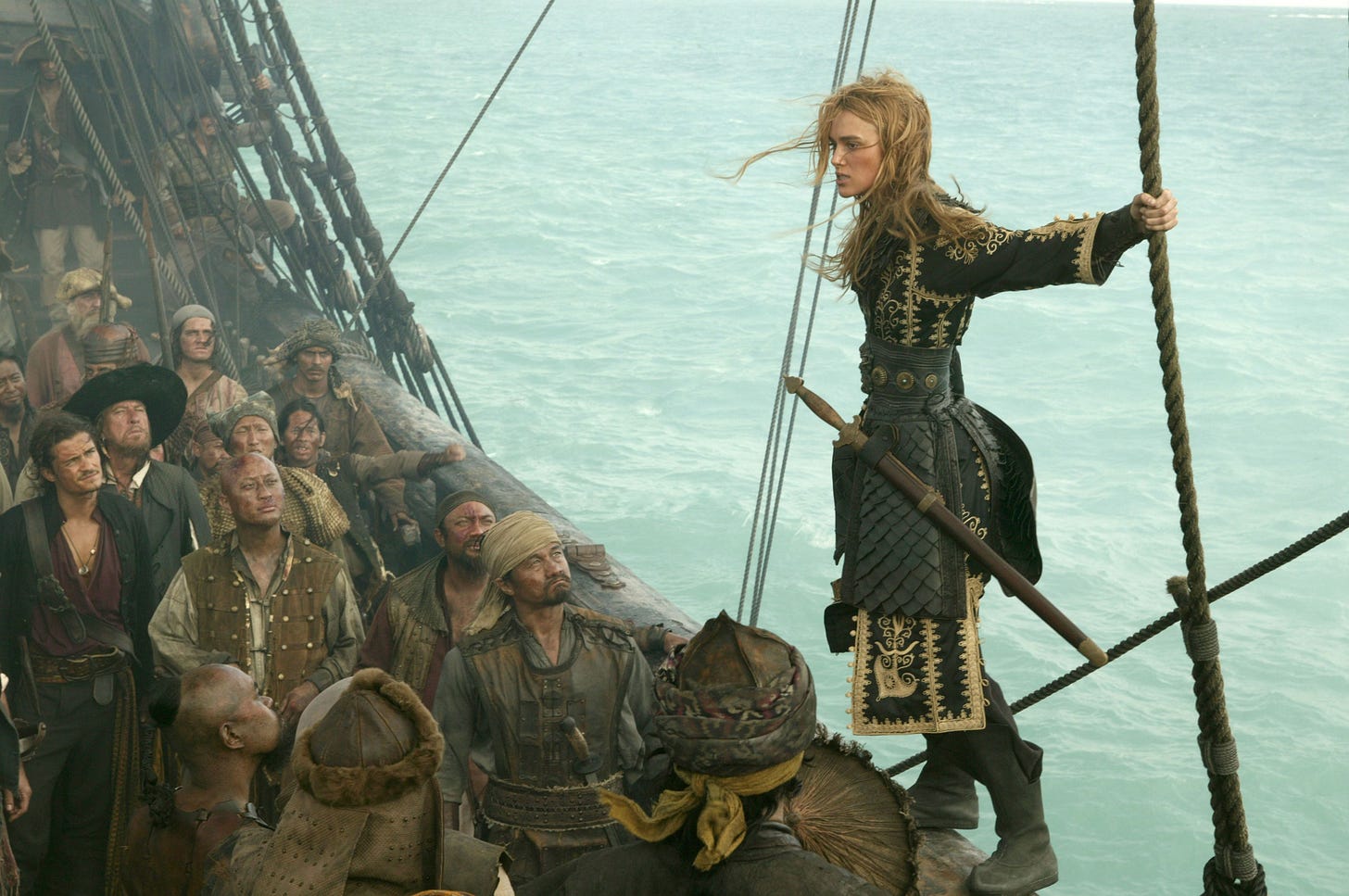Here’s why the Pirates of the Caribbean trilogy rules
We need more weirdness in our blockbusters
Welcome to ‘I loved that’, a newsletter where I, a film fan who loves pretty much everything, tries to explain why that film everyone has forgotten was good, actually.
I remember being sat in the cinema midway through the nearly 3 hour runtime of Pirates of the Caribbean: At Worlds End, the third (and final) Pirates movie, when, suddenly, I was overcome by unbearable toothache. I had bit into a malteaser and, betrayed by my favourite confectionary, I felt a searing pain radiate from my lower jaw. It’s the kind of pain that, even 17 years removed, I can still feel in my bones as I think back to it. You might think, then, that I left the cinema and went to the dentist. Or at least left the cinema to go get some painkillers? No, sir. For there was still half of an adventure left and the crew of the Black Pearl had only just escaped Davy Jones locker. In the words of Jack Sparrow, sorry, Captain Jack Sparrow, “aye, toothache is nasty but this film slaps, so stick it out.” Okay, maybe he didn’t say those exact words.
Dead Men Tell Some Tales
Pirates of the Caribbean: Curse of the Black Pearl, based on the legendary Disney ride, dropped in the summer of 2003 to rave reviews and box-office receipts in excess of $600 million. It was a huge success, reviving the pirate movie after the historic failure of Cutthroat Island in 1995, launching multiple careers and providing Disney with yet another franchise. After rewatching the film recently, I was struck by the simplicity of its execution. It’s as straightforward an adventure film as they come. Pirates need gold to lift curse, chaos ensues. All the backstabbing and backstory are doled out through action. We learn that Jack Sparrow is down on his luck but resourceful. Morally complex and selfish yet still good hearted. We learn that Elizabeth Swann is fierce, independent and intelligent and that Will Turner is impossibly handsome and great at swinging a sword and also handsome. We’re introduced to a world that feels as alive as the ride upon which it’s based and our villains sail into the story in one of the most memorable and terrifying reveals in any blockbuster. It’s a fantastic film, one that demands a sequel.
Dead Man’s Chest and At Worlds End, films two and three respectively, were filmed back to back and released in 2006 and 2007 to a more muted critical response. Critic Peter Travers said of the threequel, “there can indeed be too much of a good thing,” and legendary critic Mark Kermode described film two as rife with, “lumpen direction, lousy writing and pouting performances.”1
A far cry from the Oscar Nominated highs of the first film. The thing is, they’re wrong.
From the locker
Those last two films in Verbinski’s trilogy not only equal the first film’s successes, they build off of them to create a complex, rich and dynamic world that’s full of character, texture and heart. Classic blockbustering. Impeccably staged action that’s packed with emotion and humour. A central romance that adds weight to every betrayal and every battle. I could single out a plethora of reasons why these films rule but I really do want to keep this brief (for more analysis, I suggest watching this Just Write video).
Instead, I just want to focus on one thing; the weirdness. Making something feel truly weird is an art form and the Pirates trilogy is truly weird. Weird in a way that feels like director Gore Verbinski had so much fun concocting strange set pieces and outlandish visuals. Whether he’s sinking a ship with a Kraken or having Naomie Harris burst into a thousand crabs, Verbinski has a talent for the weird. But it’s not all just weirdness for the sake of it. There’s purpose to the strangeness. Beyond the symbolic setup - those strange white crabs hold a symbolic connection to the ocean and Harris’s Goddess Tia Dalma - the weirdness helps Verbinski establish a tone of anarchic chaos among the pirates juxtaposed with the strait laced world of real baddie Cutler Beckett. It’s what brings adventure movies their life. Consider the weird ball cages from Dead Man’s Chest and the pendulum swinging escape high above a huge crevasse. It recalls Han Solo trying to blow out the fire as the Ewoks prepare to slow roast him in Return of the Jedi. Weirdness isn’t just winking at the audience and saying, “weird, huh?” It’s using creative world-building, visual storytelling and character to create a tone. One that can be both fun and funny as well as scary and tense.
I could go on and on about why these movies are good. They are fantastic examples of classic blockbuster filmmaking at its grandest and most tactile and they’re well worth revisiting almost 20 years later. They are, as Patrick H. Willem’s describes, true ‘gonzo blockbusters’. These films, like Barbosa and Jack Sparrow, deserve a second life.
The films did fare much better with audiences both receiving A- Cinemascore’s and grossing a combined $2 billion at the box office.







